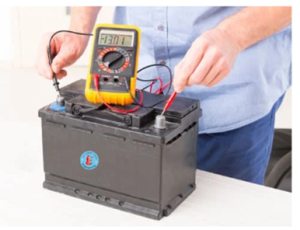Battery
In this blog you will know about:
- How to choose the right batteries?
- What are the different types of batteries?
- What are the factors to be considered while selecting the correct battery?
Batteries are like portable storehouses of energy. As we all know, how a battery works. The battery is useful to power up headlamps, lanterns, GPS devices, cameras, and many more Industrial batteries are useful for large storage applications and provide power whenever required.
The ideal battery will give you an assurance of long duration, high performance, fair cost, and low environmental impact, to get that you need to start digging into details about the electrodes, chemistry, and type of battery you want.
Tips For Choosing the Right Battery
- Figure out what size batteries you need: – this is the simple need to check how much battery your device can store; you can look on the device itself for an indication of what battery size it takes. What is your application and storage capacity? Depending on that you can figure out the battery.
- Decide between rechargeable and non-rechargeable battery: – as we are aware that battery has two types primary (non-rechargeable battery) and secondary (rechargeable battery). Primary batteries are cheaper and have an excellent shelf life, but rechargeable batteries can be used again and again making them ultimately a cost-effective choice, according to your need and application you can choose the type of battery you want.
- Get the right type of battery: – Understanding how batteries work and knowing how alkaline differs from lithium and NiMH from lithium-ion will help you pick the best battery for your application.

Whenever you are going to choose the right battery according to your need you may be comparing the different battery types at different price points and other specifications and configurations. To help you in selecting the g correct battery for your use here is a simple guide comparison between the batteries
Lead Acid Battery
There are three distinct types of lead acid batteries, and their comparison is below.
- Flooded Lead Acid Battery
- Sealed Lead Acid Battery (GEL and AGM battery)
Flooded Lead Acid Battery (Wet Lead Acid Battery)
The flooded lead acid battery is also known as a Flooded lead acid battery. These batteries are commonly used in large UPS systems for the deep cycle and standby operations and used in vehicles these are the most cost-effective solutions for storage. Flooded batteries are the most common type of lead acid battery and are widely used in automotive they are called flooded because of the acid that is free flowing within the case in which the battery is suspended. When you need the most Ah possible in a size-constrained location, then flooded batteries are likely your best choice.
These batteries are meant to be mounted upright so that the electrolyte does not leak out of the caps on top. While this is the most economical battery on the market, it will only reach its potential lifespan if maintained properly. The levels must be checked monthly and topped off with distilled water to ensure the longest possible lifespan.
Note: flooded lead-acid batteries release toxic hydrogen gas when charging. They need to be enclosed and vented to the outside to prevent this gas from being trapped and creating a hazardous environment.
Advantages:
- Suitable under bonnet use
- Cost-effective
- Easy to maintain
- Can hold the high temperature
Disadvantages:
- Acid can be spilled
- Regular maintenance required
- Shorter lifespan
- Emits toxic gas if an internal fault occurs
Sealed Lead Acid Battery
The sealed lead-acid batteries are very similar to the flooded version, but there is no access to the inside compartment. This means that you do not have to fill distilled water. The electrolyte is sealed inside.
You sometimes see these referred to as VRLA (valve-regulated lead-acid) batteries, because they have a small valve to allow for the escape of the gases that occur during charging.
AGM (Absorbent Glass Matt)
Absorbent Glass Mat batteries are the most popular VRLA battery because they can work in a wide range of conditions. The electrolyte is suspended in a thin fiberglass mat that is situated between the lead plates. This allows the battery to be resistant to vibration, which makes them a great choice for RV and other mobile applications. The main advantage of this battery is that is fully sealed and maintenance-free. With these benefits, they generally have a longer lifespan.
AGM batteries are more expensive than flooded lead-acid batteries, and they do not last quite as long. But for that extra price, you get the luxury of not having to maintain the batteries or deal with as much gas that is released during the charging phase.
They are perfect for mobile applications, places where leaked acid would be problematic, remote locations where maintenance will not be possible on a regular basis, and places where the batteries could be subject to extremely cold temperatures.
Advantages:
- It resists vibration
- Recharges faster
- Cycles more and last longer in demanding applications
Disadvantages:
- Manufacturing costs are higher, making the batteries more expensive.
- They are sensitive to overcharging and high voltages and require full charging between uses
GEL Battery
Gel batteries are another VRLA battery very much like an AGM, but they use a thick paste that allows the magic to happen rather than the fiberglass mat.
The main difference between gel and AGM batteries is the charge rates. AGM batteries can handle higher charge and discharge rates than gel batteries.
Gel batteries are more expensive than other lead-acid battery types, so they are not ideal outside a handful of specific solar applications (very hot climates, mainly).
Gel batteries are the most sensitive of the VRLA batteries, and it is critical that the correct charging parameters are used when you have a Gel battery in your application.
Advantages:
- Maintenance free. When the battery is charging, hydrogen would be absorbed and reversed to the electrolyte by plates
- Flexible installation
- Longer lifespan in extreme weather
- Long standby life, better cycle performance
- Longer shelf life
- High-rate performance
Disadvantages:
- Gel batteries are very delicate things; one mistake in charging them will ruin the battery completely, even if it is new.
- High initial cost.
- In case of overcharging water cannot be refilled.
- Special chargers and regulators are required.
- Hot temperatures can affect adversely acid can turn the gel hard and may shrink away from plates.
Li-ion Battery
Both Li-ion and lead acid batteries work by storing and releasing electrons through electrochemical processes. Li-ion batteries work by discharging positive and negative ions from the material lithium between electrodes. Lead acid batteries work by using a similar process, only different material.
In most cases, li-ion battery technology is superior to lead acid due to its reliability and efficiency among other elements. Below are some points which will help to compare lead acid and li-ion batteries.
- Cost: if you compare the battery’s costs wise lead acid batteries are seemingly better than the li-ion battery option in cost. While lead-acid batteries typically have lower purchase and installation costs compared to lithium-ion options, the lifetime value of a lithium-ion battery evens the scales.
- Capacity: A battery capacity means how much energy can be stored and eventually discharged by the battery. While the capacity numbers vary between the battery models and manufacturers, Li-ion battery technology is well-proven to have a significantly higher energy density than lead-acid batteries. This means that you can store more energy in a similar space with a Li-ion battery and can power more appliances for longer periods of time than the lead acid battery
- Depth of discharge is the percentage of the battery that can be safely drained of energy without damaging the battery. While it is normal to use 85% or more of li-ion batteries’ total capacity in a single cycle lead acid batteries should not be discharged past roughly 50% as doing so negatively impacts on battery lifetime. Li-ion battery has higher energy density than lead acid battery.
- Efficiency: just like solar panel efficiency, battery efficiency is an important factor to consider when comparing different options. Most li-ion batteries are 95% more efficient or more of the energy stored in li-ion batteries is actually to be used than lead acid batteries. On other hand, lead acid batteries see efficiencies closer to 80 to 85 percent. Higher efficiency batteries charge faster, and similarly to the depth of discharge, improved efficiency means a higher effective battery capacity.
- Lifespan: Battery is also similar to solar panels in that they reduce over time and become less effective as they age. Discharging a battery to power your home or appliances and then recharging it with solar energy as a grid counts as one cycle. Lithium-ion batteries generally last several times the number of cycles as lead acid batteries, leading to a longer effective lifespan for lithium-ion products.
Advantages
- longer lifetime
- higher efficiencies
- higher energy density
- Lithium-ion batteries stand up well to repeated charging and discharging
For more information, please feel free to contact us at: shila@iengaust.com.au & kirti@iengaust.com.au




